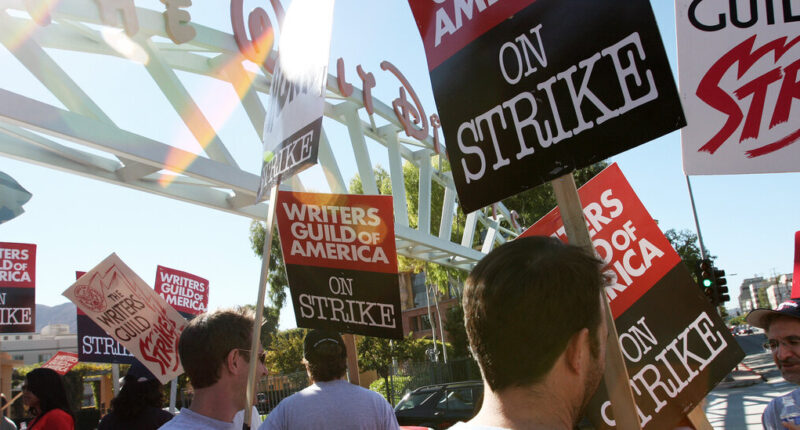
Television and movie writers want raises, saying that Hollywood companies have taken unfair advantage of the shift to streaming to devalue their work and create worsening working conditions.
The companies bristle at the accusation and say that, while they are willing to negotiate a new “mutually beneficial” deal with writers, the demands for an entirely new compensation structure ignore economic realities.
Whether the sides can settle their differences will determine if the entertainment industry can avoid its first writers’ strike in 15 years.
Unions representing more than 11,000 television and movie writers and the Alliance of Motion Picture and Television Producers, which bargains on behalf of Hollywood’s nine largest studios, including Amazon and Apple, began talks on March 20 for a new three-year contract. The current agreement expires on May 1.
The Writers Guild of America, West, and the Writers Guild of America, East, have the strength to bring Hollywood to a halt if they do not get a deal to their liking. Chris Keyser, a co-chair of the W.G.A. negotiating committee, said in an interview that this moment for writers was “existential.”
“The industry is almost always unfair to labor,” Mr. Keyser said. “This time it’s broken — it’s actually broken.”
Here is what you need to know:
Will there be a strike?
No outcome is certain, but little in the posturing so far suggests an easy resolution. Producers have begun to stockpile scripts by asking writers to complete as many ahead of the May 1 deadline as possible.
The negotiations will likely be acrimonious given the seismic changes in the industry. The rapid transition to streaming entertainment has upended nearly every corner of Hollywood, and writers believe they have been left behind.
Unlike directors and actors, writers have historically been willing to strike. The most recent strike stretched from 2007 into 2008, lasting 100 days. One in 1988 dragged on for five months. A walkout must first be authorized by union members; the W.G.A. has signaled that it could conduct a vote as early as the first week in April.
Authorization gives the union leverage, but it does not mean a strike is inevitable. In 2017, writers overwhelmingly gave the go-ahead for a strike (with 96 percent of the vote). The sides ultimately reached an agreement a few hours before the first pickets hit studio sidewalks.
How would a strike affect audiences?
There will be a gradual halt in the production of many television shows, except for reality and news programs, which would be mostly unaffected.
Viewers will notice the fallout first among entertainment talk shows, including “The Late Show With Stephen Colbert” and “The Tonight Show Starring Jimmy Fallon.” If a strike lasts several weeks, “Saturday Night Live” would not be able complete its season. Soap operas, already on viewership life support, would run out of new episodes after about a month.
Labor Organizing and Union Drives
Plenty of high-profile TV series have coming seasons that are already finished. But premieres for fall series like “Abbott Elementary” would be delayed by a monthslong strike, and viewers would begin to notice fewer scripted TV series by the end of the year. Reality and international shows will start to run in heavy rotation.
Moviegoers would not experience immediate effects; movie studios work about a year ahead, meaning that almost everything planned for 2023 has already been shot. The risk involves 2024, especially if studios rush to beat a strike by putting films into production with scripts that aren’t quite ready.
What are the writers’ complaints?
Every three years, the writers’ union negotiates a contract with the major studios that establishes pay minimums and addresses matters such as health care and residuals (a type of royalty), which are paid out based on a maze of formulas.
And though there has been a boom in television production in recent years (known within the industry as “Peak TV”), the W.G.A. said that the median weekly pay for a writer-producer had declined 4 percent over the last decade.
Because of streaming, the former network norms of 22, 24 or even 26 episodes per season have mostly disappeared. Many series are now eight to 12 episodes long. At the same time, episodes are taking longer to produce, so series writers who are paid per episode often make less while working more. Some showrunners are likewise making less despite working longer hours.
“The streaming model has created an environment where there’s been enormous downward pressure on writer income across the board,” David Goodman, a co-chair of the guild negotiating committee, said in an interview.
Screenwriters have been hurt by a decline in theatrical releases and the collapse of the DVD market, union leaders said.
Between 2012 and 2021, the number of films rated annually by the Motion Picture Association fell by 31 percent. Streaming services picked up some slack, but companies like Netflix and Warner Bros. Discovery, which owns HBO Max, have been cutting back on film production to reduce costs amid slowing subscriber growth.
Are the companies in a position to pay more?
They would argue this isn’t the best time for it.
Disney said in February that it would cut $5.5 billion in costs and eliminate 7,000 jobs to address streaming losses, an atrophying cable television business and steep corporate debt. Warner Bros. Discovery has already cut thousands of jobs as part of a $4 billion retrenchment. NBCUniversal is also tightening its belt as it contends with cable cord-cutting and a troublesome advertising market.
The writers are unmoved by this. Mr. Keyser noted that Netflix is already profitable (to the tune of $4.5 billion last year), and that rival companies have said their streaming services will be profitable in the next year or two. “We don’t get to negotiate again until 2026,” Mr. Keyser said. “We’re not waiting around until they’re profitable.”
Who’s doing the negotiating?
In a rarity for Hollywood, the chief negotiators are both women. Carol Lombardini, 68, leads the studio effort; she has worked at the producers’ alliance for 41 years. Ellen Stutzman, 40, leads the W.G.A. effort. She was appointed only about a month ago, after David Young, who has served as the ferocious negotiator for writers since 2007, stepped aside, citing an unspecified medical problem.
Ms. Stutzman, who has been with the W.G.A. for 17 years, said in an interview that Mr. Young would play no part in these negotiations. She called him “a wonderful mentor.”
Are the studios aligned?
Absolutely, according to the producers’ alliance. “The A.M.P.T.P. companies approach this negotiation and the ones to follow with the long-term health and stability of the industry as our priority,” the alliance said in a statement, referring to impending contract renewal talks with directors and actors. “We are all partners in charting the future of our business together and fully committed to reaching a mutually beneficial deal.”
But differences start to appear when you talk to senior executives on a company-by-company basis. In private conversations, they point out that the group is much less monolithic than in the past. It now includes tech companies like Amazon and Apple, for example, whose primary business is not entertainment.
Is the W.G.A. united?
For generations, ever since the end of the silent film era, Hollywood writers have complained that studios treat them as second-class citizens — that their artistic contributions are underappreciated (and undercompensated), especially compared with those of actors and directors. This sentiment runs deep among writers and has historically resulted in extraordinary unity.
In 2019, when film and TV writers fired their agents in a campaign over what they saw as conflicts of interest, many agency leaders figured that the W.G.A. would eventually fracture. That never happened: After a 22-month standoff, the big agencies effectively gave writers what they wanted.
What about collateral damage?
Tens of thousands of entertainment workers were idled during the 2007 strike, and the action cost the Los Angeles economy more than $2 billion, according to the Milken Institute. This time around, many of the small businesses that service Hollywood (florists, caterers, chauffeurs, stylists, lumber yard workers) have only started to regain their footing after pandemic shutdowns, increasing the stakes of a strike and potentially leading to community fissures.
Source: | This article originally belongs to Nytimes.com









